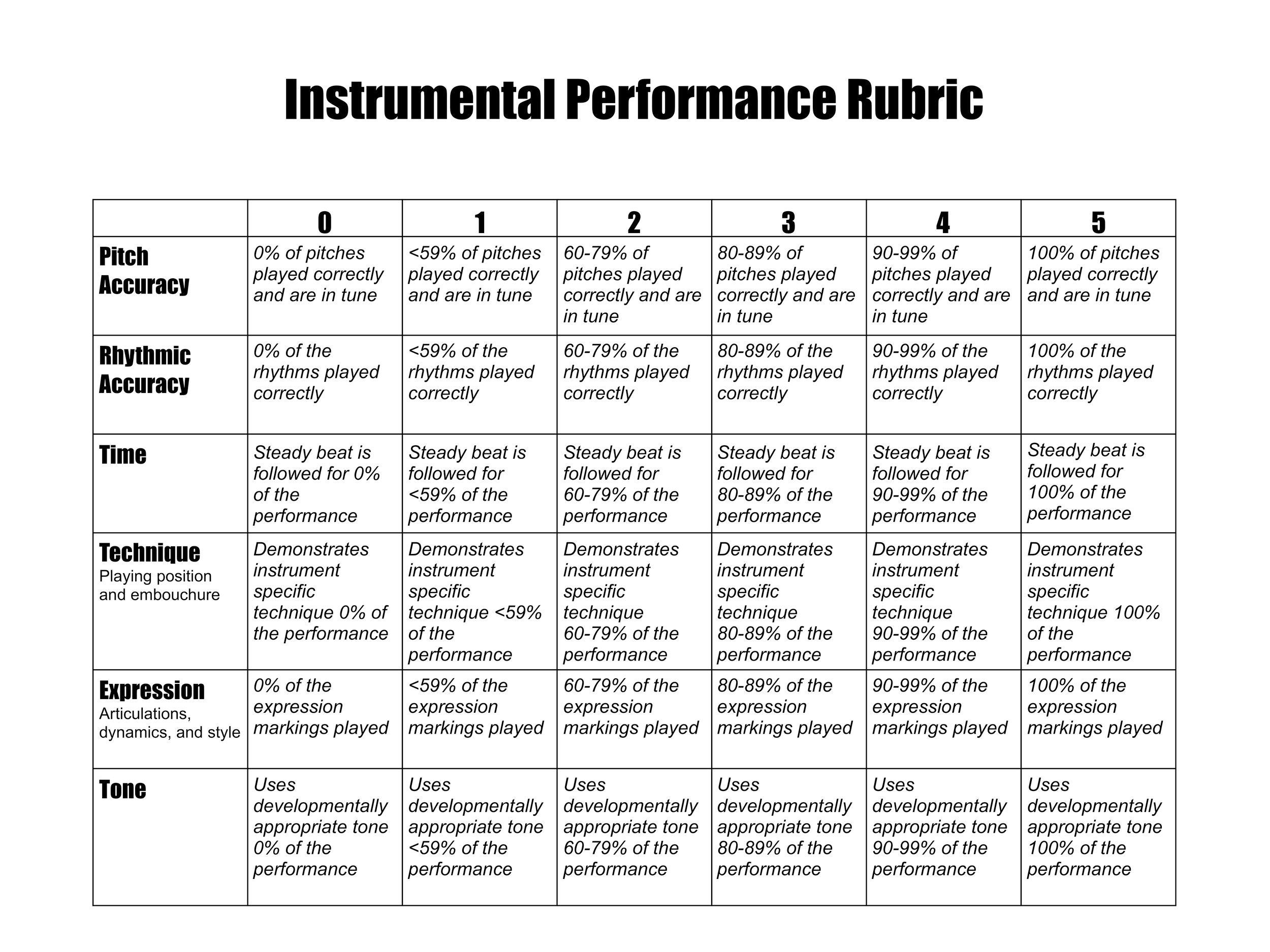Independent Musician Steps To Mastery
Learning music is a process that should follow a sequence based on level of importance. A performance suffers If essential parts of the whole aren’t represented.
Example: a musician can play the pitches to a part because it is a familiar melody or because they have heard other members of their section play it, but they guess on the rhythm during practice and performance. No matter how much attention that musician puts on expression, style, articulation, and tone; their performance will always have a fundamental flaw that will have negative effects on the rest of the ensemble. These steps are a suggested sequence for practicing music. With enough experience, some steps will be able to be done during sight reading while others will still require active attention.
Using Seesaw and Skill Indexes
Check out the video on how to use seesaw and the Shed's skill indexes to create digital portfolios for your music classrooms.
Practice Strategies
Practice Strategies
There are many strategies that you can use while practicing. They work differently in different situations and for different people. Try some of these thirteen strategies in your next practice session.
Elemental isolation
It helps to break down a section into different musical elements: clap only the rhythm, play only the pitches, and/or practice just the articulations and dynamics.
Keep your brain in front of your fingers by slowing the music to a tempo you can correctly play. Slowly ramp up the speed until you reach performance tempo and always use a metronome!
Slow it down
Interval training
Take one section of a piece and practice it using different time intervals of work and rest.
Circuit training
Choose 2-5 different sections either in the same piece or in different pieces of music. Switch from section to section using a set amount of time.
Error targeting and transitioning
Find the problem spot and focus your energy on making it sound as good as the rest of the piece. Practice transitioning into and out of the problem spot by starting a measure or two before the error and going a measure or two after.
Take a break
When you find yourself making the same mistakes over and over, taking short breaks allows you to reset your brain.
plow through
It doesn’t matter where you are in learning a piece, it is always a good idea to try to get through the whole thing mistakes and all.
Mental practice
You can imagine your sound, the sound of the group, the fingerings for each note, the rhythms, and the tools of expression all in your head. This especially helps with memorization.
One measure at a time
If a song is difficult, practicing it can feel overwhelming. Take a deep breath, count to four, and take it one measure at a time.
Chunking
Learn your piece section by section. You can seperate them by logical musical phrases, label them, and sort them by difficulty. Once sorted, it is easy to see what to practice first!
Start at the end
Logically people learn a piece from the beginning and work linearly throughout the work. Shake it up a bit and start at the end.
Overtrain
If your piece is supposed to be played at 120 BPM, try nailing it at 150! Being able to play your piece at a higher level of difficulty allows you to feel prepared to perform it.
Whole part whole
Alternate playing the whole piece and playing part of the piece. Practicing this way allows you to see how each part functions in the whole.
How to write your own licks
Lick Creation
There are parts of tunes where ii-V licks won't work. In order to play through these sections, you need to be able to write your own licks. Using arpeggios and digital patterns combined with bebop ornamentation will give you a good starting point for lick creation. It helps to have a good foundation in chord spelling when dealing with these concepts. Check out our chord page for help!!! You can also change chords by using the five rules of chord substitution.
Digital Patterns
A digital pattern is a sequence of notes in a scale. The first step is to find the parent scale of the chord. D-7 is the ii in the key of C. Let's use the sequence of 1235 for this chord.. You would take the notes of the C major scale, but start counting on the root of chord resulting D E F A . Any number combination will work for a digital pattern. Experiment with the sounds that you like.
Arpeggios
An arpeggio is when notes of a chord are played in order going up or down. The notes in a chord starting on the root are: The R, 3, 5, 7, 9, 11, and 13th. An arpeggio can start on any of these chord tones and you can use as many or as few notes as you want.
Bebop Ornamentation
The creators of the bebop sound used different embellishments around certain notes in their licks. Here are the four most common bebop ornamentation.
Lick Writing
The first chord of All The Things You Are is F-7 which functions as the vi in the key of Ab. You could turn this into a ii-V or you could write your own lick
The secret to playing the most killer jazz solos ever is...
Listening. If you ask any jazz artist, thats one of the first things they will say. Check out these listening playlists to get the sound in your ear.
Big Band
The Basics
Soul Jazz
Current Trends
Never Have To Count A Rhythm Again!!!
When you're on the gig, you don't have time to count rhythms out. They need to be accurate and in the pocket every time. It usually takes years of experience with counting rhythms to get to this level of mastery, but there is a faster way. Follow these steps to become a rhythm machine.
1. Counted Rhythms- Familiarize yourself with beat, meter, note values, ties, and dots. These are the building blocks of all rhythm.
2. Subdivision- A beat can be divided in equal parts. Being able to feel the different parts, or subdivisions, will allow you to play your notes on time, every time.
3. Sight Rhythms- Connecting what a rhythm looks like and what a rhythm sounds like is a process that takes a long time. Learning sight rhythms streamlines that process and makes it easy to play what you see.
Putting jazz into the blues...
Blues Call And Response
One of the best ways to acquire new language is through call and response. Our call and response page moves students from single note recall to hearing the changes in a I-IV-V progression.
One Step Blues Etudes
Are you only using the blues scale to play over the blues? There is so much more to playing the blues than a scale. What about the change in harmony in measure 5 (the IV chord) or the ii-V that is often used over the last four measures? Check out the following guides on composing a jazz solo over an F blues. All you need to do is plug in the blues licks, ii-v's, and simple chord tones and wa la, you have the start of a pretty good solo. Don't forget to practice it till you own it!
Two Step Blues Etudes
1. Choose a lick from each other the three phrases of the blues!
2. Transpose it into the desired key!
Original key
Transposed to B Flat
The Big Three: Essential Theory Concepts That You Can Use TODAY
These three skills will elevate your musicianship to the next level!!!
1. Memorize all 12 major scales. It's one thing to be able to use mnemonic devices or intervals to figure out major scales and it's another thing to CRUSH your major scales. You don't want to have to think about major scales when improvising or composing. This skill needs to be mastered: being able to do something as many times as you want, without having to think about it, and without making any mistakes. CLICK HERE TO LEARN YOUR SCALES!!!
2. Master the order of thirds. Having the order of thirds in your back pocket frees up your mental capacity. The order of thirds will help with anything to do with chords: reading, spelling, comping, and improvising CLICK HERE TO LEARN THE ORDER OF 3RDS!!!
3. Know the circle of fourths. There are so many shortcuts that use the circle of fourths. If you know the circle like the back of your hand, you will be able to do much more with less thinking. The Circle of fourths will help with identifying ii-V's and finding the parent scales. CLICK HERE TO LEARN THE CIRCLE!!!
How to write a jazz etude
Have you ever looked at chord changes and had no idea what to do? Have you ever taken a solo, and it sounded like you were playing a different song than the rest of the band? Jazz solos are usually spontaneously created, but if you don't know what to play, writing out a jazz etude is a great place to start.
0. Start by writing either a one step or two step blues etude
1. Pick a tune from our guided lead sheet page.
2. Boil down changes
WTF - what the function? Some lead sheets or big band charts have a lot of unnecessary harmonic information.
3. Identify and classify ii-V's
Find the ii-V chord progressions in the chart. Look for minor 7 to dominant 7 to major 7 chord qualities that have roots which are a fourth interval apart. To find the key center of a ii-v without a I, go up a fourth interval from the dominant 7 chord.
The ii chord in a minor key is a minor 7b5 (ø7) and the V chord is a 7b9.
4. Choose a lick and transpose it to the correct key.
5. Write licks for non ii-V based chord changes
6. Connect licks
Using the same lick over a new chord or using the same lick over a different part of the chord is called a sequence. Sequences can be either diatonic (in the key) or chromatic (outside of the key).
Certain notes in a chord have a tendency to lead to a particular note in the following chord. The 3rd of one chord leads to the 7th of the next or vice versa. The 5th and 9th have the same relationship. Using these tendencies when going from one lick to the next helps keep continuity in your lines.
7. PRACTICE TILL YOU OWN IT!!!
The only way for an etude to work is to make it sound like YOUR solo. Memorize it and be able to play it at multiple tempos. Sing your solo. Test yourself and try to write out your solo IN A DIFFERENT KEY!
8. LISTENING AND TRANSCRIPTION
Listening is the best way to get the sound and feel of jazz into your ear and into your playing. Here are some listening examples to get you started. Find one tune you like and dig in. Don't just listen to it once! Work on transcribing your own licks using our guided transcription page. Transcribing is THE BEST thing you can do to improve your ear and to acquire new language.












